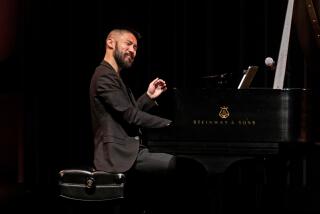A Multimedia Tribute to Billie Holiday, Italian Style
- Share via
American jazz has been enticing classical composers for more than a century--and beyond that if one includes such antecedents as ragtime, spirituals and traditional music.
Results of that fascination are apparent in the music of, to name only a few, Dvorak, Stravinsky, Gershwin, Copland, Bernstein, Stockhausen and beyond.
Since the avant-garde jazz breakout of the ‘60s, the lines between genres have become increasingly blurred, as improvisation has increased in the classical area, and methodology involving aleatoric techniques, tone rows, complex rhythmic meters, etc., have surfaced in jazz.
As a result, a growing number of musicians--especially in Europe--have moved freely from one arena to the other.
Italian trombonist-composer Giancarlo Schiaffini has been active in both genres since the ‘70s. On Wednesday night at the Istituto Italiano di Cultura in Los Angeles, he premiered “Rhapsody for Billie,” a multimedia work including his own trombone playing, the voice of Silvia Schiavoni, projected photo images by Ilaria Schiaffini (Giancarlo’s daughter) and a prerecorded tape filled with snippets of sound and rhythm.
The composition was, of course, a tribute to Billie Holiday, featuring fragments (sometimes more) of songs associated with her--”The Man I Love,” “Lover Man,” “Yesterdays,” “God Bless the Child” among them. Behind Schiaffini and Schiavoni, who were positioned on opposite sides of the stage, a large video screen offered intermittent, often abstract, usually modified, images of Holiday.
The song passages unfolded seamlessly around narrative segments serving as an imaginary Holiday stream of consciousness. Most were sung and spoken by Schiavoni, with Schiaffini adding dramatic punctuation, and periodically taking center stage to offer an instrumental variation.
It was Schiavoni, however, in effect playing both the musical and the emotional role of Holiday, who brought the work to life, brilliantly shifting from convincing jazz phrasing and scat-like blues lines to bursts of soprano shrieks and cries. At its best, her extraordinary eclecticism was reminiscent of the work of the versatile contemporary classical singer, Kathy Berberian.
Schiaffini’s composition had its uneven moments, especially when the prerecorded tape relied too heavily upon synthesizer passages. But whenever Schiavoni’s voice was front and center, “Rhapsody for Billie”--despite its experimental aspects--became a penetrating and insightful study, through music and sound, of a turbulent jazz life.
More to Read
The biggest entertainment stories
Get our big stories about Hollywood, film, television, music, arts, culture and more right in your inbox as soon as they publish.
You may occasionally receive promotional content from the Los Angeles Times.










